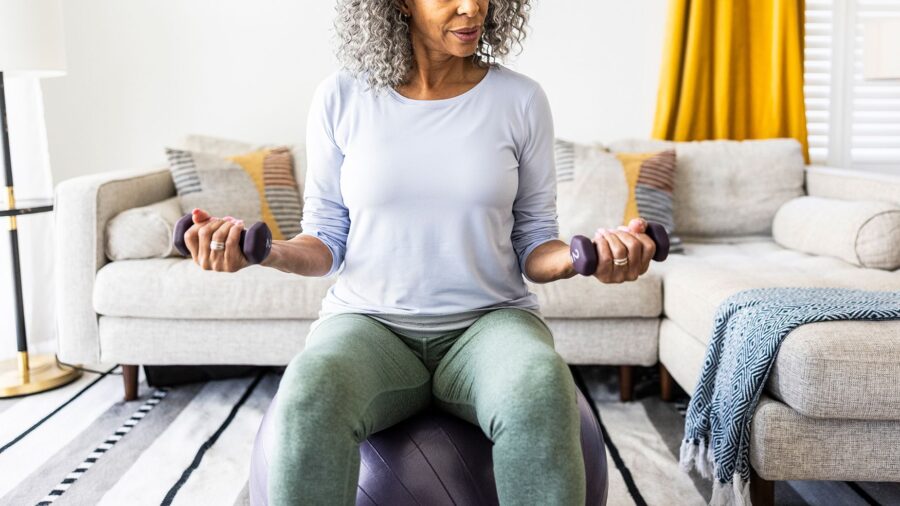Women need to exercise and eat differently than men. Here’s how
May 2, 2024, 1:45 PM

Women of all ages should focus on strength training to help reduce risk of dementia, said exercise physiologist and nutrition scientist Dr. Stacy Sims (not shown). Mandatory Credit: MoMo Productions/Digital Vision/Getty Images via CNN Newsource
(not shown)
Editor’s note: Melanie Radzicki McManus is a freelance writer who specializes in hiking, travel and fitness.
(CNN) — As reproductive health remains a key issue in the 2024 US presidential election, a recent executive order signed by President Joe Biden to improve women’s health research grabbed headlines. The March 18 directive is notable for its aim to integrate women’s health across federal agencies and drive new research. The timing could not be better.
For centuries, medical researchers have exclusively studied men, downplaying or outright ignoring sex differences and extrapolating their findings to women. However, women are not physiologically the same as men — marked most plainly with the onset of menstruation at female puberty and two X chromosomes — and thus have often been given incomplete, poor and even harmful medical advice.
This long-standing lack of female-based research stemming from sex and gender bias spurred Dr. Stacy Sims, an exercise physiologist and nutrition scientist based in Mount Maunganui, New Zealand, to devote her career to determining how women should be eating and exercising for optimal health. “If we work with our physiology knowing that women are women and men are men, knowing that women are not small men, then imagine the (health) outcomes,” she said at a 2019 TED talk.
READ MORE: Lab rats are overwhelmingly male, and that’s a problem
Cardiac arrest is a good example. While it was known in 2007 that women are nearly twice as likely to die from heart attacks as men, and that they report many more symptoms associated with acute coronary syndromes, a National Institutes of Health study published that year still recommended against differentiating heart attack symptoms between men and women.
Even today, women remain broadly underrepresented in medical literature, according to a study published in 2022 in Women’s Health Reports. Misogynistic attitudes remain as well. And while the US National Institutes of Health in 2016 implemented a policy requiring researchers to consider sex as a variable in their biomedical research, the results were mixed.
The number of studies including women did noticeably increase after this policy debuted. However, a 2019 bibliometric analysis — a rigorous means of analyzing large volumes of data — showed the majority of more than 700 medical studies failed to analyze the resulting data by sex, limiting their usefulness.
Sims, who is also author of the science-based book “Roar,” which details sex-based differences in exercise and nutrition at different life stages, recently shared her thoughts on the topic with CNN.
Before beginning any new exercise program, consult your doctor. Stop immediately if you experience pain. This conversation was edited and condensed for clarity.
CNN: How can it possibly be that women are still so medically understudied in 2024?
Dr. Stacy Sims: I know! Isn’t it crazy? Historically, when you think about who developed science and research, women were pushed out right at the start. The men were like, “Oh, women are lesser beings than us. They have smaller brains.” Even Darwin said that women weren’t as smart because they have smaller brains. So when you think about scientific method and how it all started, who were the people in the room? It was all men. No one really questioned the lack of women being studied. They just assumed women were smaller versions of men, so whatever works for men works for women. Tradition is really hard to change.
One thing the Covid-19 pandemic did do that I appreciate is cause researchers to sit up and say, “Holy sh*t, we really need to look at sex differences.” Because Covid-19 was more severe in men, yet side effects of the vaccine were more prominent in women. Also, long Covid has hit women more severely and has affected their brain more than men. That’s why we’re seeing all of this sex-specific stuff coming out that’s really good science instead of just generalized.
CNN: What are some basic things all women should be doing when it comes to exercise?
Sims: Any movement is good, but it’s more important that women put in strength or resistance training. It’s more for brain health. If we look at resistance training and the neural pathways it creates, we’re seeing it really does help attenuate dementia and Alzheimer’s — and there is a sex difference there as well. Historically, though, women haven’t been directed into doing resistance training. But across the board, from young to old, women should be doing strength training.
CNN: Does strength training have other impacts as women approach menopause?
Sims: Yes. When our hormones start changing between 40 and 50, it has a massive impact on our body composition. We start losing muscle and putting on more body fat. But if we have that lean mass from strength training, it really helps calm down that rate of change. Strength training also helps protect our bones and helps us keep our balance and proprioception (the awareness of where our body is in space). We don’t see these kind of changes in men until they’re in their late 50s to 70s.
CNN: What about exercise differences between the sexes when it comes to cardiovascular work?
Sims: Men can pretty much get away with everything. Women already have the capability of going long and slow, so we don’t need to do that kind of exercise — our bodies are already there. What we do need to do is high-intensity work: those true high-intensity intervals of 30 seconds or one minute. This helps women raise their metabolic rate, it helps reduce visceral (deep belly) fat and, most importantly, it helps keep our gut microbiome diverse and helps improve cardiovascular health. So when we look at all the research on high-intensity versus moderate-intensity versus low-intensity workouts, we really need to push the emphasis for that high-intensity work, plus resistance training.
CNN: Do women recover from exercise the same as men?
Sims: Right after exercise, there is a blood pressure difference. Women will experience vasodilation, so all their blood will go to the periphery, whereas men will have vasoconstriction, which means all of their blood comes back to their heart and can be pumped a lot faster for a quicker recovery. So women tend to get lightheaded and feel a little dizzy after a hard session, because all of their blood is pooling out. Drinking something cold right after exercise helps bring that blood back centrally, reduces metabolites and starts the reparation process.
CNN: What about nutritional differences between the sexes?
Sims: There is a big conversation around protein intake and how the recommended daily allowance for women is really low. It’s also based on cadaver work on 70- to 80-year-old men. So while protein is important for both sexes, we need to emphasize it for women — and especially as we age, since women become more anabolically resistant to exercise and protein intake, which means their bodies don’t respond as well to exercise and protein intake to build muscle. So it takes more protein, post-exercise, and higher loads or more volume of resistance training to get muscle protein synthesis.
In general, women should have 1 to 1.1 grams of protein per pound of body weight per day. If you’re doing strength training, have 15 grams of protein before a session and 30 to 35 grams after, which helps with strength and facilitating reparation. For cardiovascular work, have 15 grams of protein with 30 grams of carbohydrates before — the carbs help bring your blood sugar up, because women’s bodies go through blood sugar quickly — but afterward is when you need protein — 30 to 35 grams, or 40 grams for perimenopausal and early post-menopausal women.
CNN: There has been a lot publicized recently about the benefits of intermittent fasting, training in Zone 2 — long and slow — and other fads. Are these equally beneficial to men and women?
Sims: Most of the trends out there are great for men, but it’s a different story for women. My voice is always, “Let’s show why what we’re seeing for the general population is not appropriate for women, but also, what is appropriate for women?” Because no one’s used to pausing and saying, “OK, I heard this. But what was the population it was studied on? If it was studied on men, it might not be great for me as a woman. Well, what is appropriate for me?” It’s too many steps.
The-CNN-Wire™ & © 2024 Cable News Network, Inc., a Warner Bros. Discovery Company. All rights reserved.













